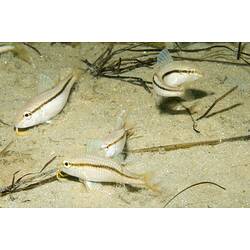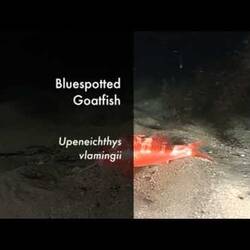General Description
Body moderately long, compressed, dorsal profile steep in front of dorsal fin; snout long, mouth small with fleshy lips, jaws not reaching below front of eye, chin with a pair of prominent sensory barbels. Colour highly variable, from overall greyish-cream, pale greenish, or pinkish to orange-red; some individuals with a reddish to blackish stripe from snout, through the eye to tail base; others with blue lines and spots. Individuals can rapidly change colour. Usually 18 cm long head to tail tip (up to 30 cm).
Biology
Bluespotted Goatfish are frequently seen probing the bottom with their distinctive chin barbels, literally smelling or tasting for signs of food. The colour pattern of this species is highly variable from juveniles to adults, and a single individual may change colour pattern depending on threats and the time of day.
Distribution
Southern Australia.
Habitat
Shallow sandy areas often near rock and weed in coastal waters and bays, to depths of 40 m.
More Information
-
Animal Type
-
Animal SubType
-
Brief Id
Chin with yellow barbels, body whitish to pinkish with a black stripe, or reddish with bright blue spots and wavy lines.
-
Habitats
-
Diet
Carnivore
-
Endemicity
-
Commercial
Yes
-
Conservation Statuses
CITES: Not listed, FFG Threatened List: Not listed, EPBC Act 1999: Not listed, IUCN Red List: Not listed
-
Depths
Deep ( > 30 m)
-
Water Column Locations
On or near seafloor
-
Taxon Name
-
Scientific Author
(Cuvier, 1829)
-
Common Name
Bluespotted Goatfish
-
Other Names
Red Mullet
-
Kingdom
-
Phylum
-
Subphylum
-
Superclass
-
Class
-
Order
-
Family
-
Genus
-
Species Name
vlamingii






